In this Article
Which is better, an email list of 50,000 or an email list of 5,000?
Anyone would pick 50,000 subscribers over 5,000. But that number is only as good as the engagement you receive. If that 50,000-person list doesn’t see many opens or clicks…then it’s probably time to evaluate your email marketing program.
That’s exactly why registered dietitian and entrepreneur Jessica Beacom and her team at Real Food Dietitians decided to switch from Mailchimp to Kit in May 2021.

From left-to-right: Jessica Beacom, Stacie Hassing, and Jessie Shafer, the team behind Real Food Dietitians.
They launched their business back in 2015 as a meal delivery service before pivoting to what they love most: offering healthy recipes and meal plans delicious enough that real people would want to eat them.
“We started writing a food blog, and it just sort of snowballed,” says Jessica. “11 months later, we started making a profit on our food blog alone, and we were able to pay ourselves our first paycheck of $126.”
It’s rare for a food blog to turn a profit in a short time. The secret? Starting an email list ASAP. “We started our email list from the beginning, with our first 20 people, and started sending out an email every single week. Even if we felt like we had nothing to say.”
Since then, The Real Dieticians kept on consistently creating, building out their blog content, and sharing their favorite food recipes and tips. Today, they average 1.5 million page views per month and run a subscriber list of 58,000.
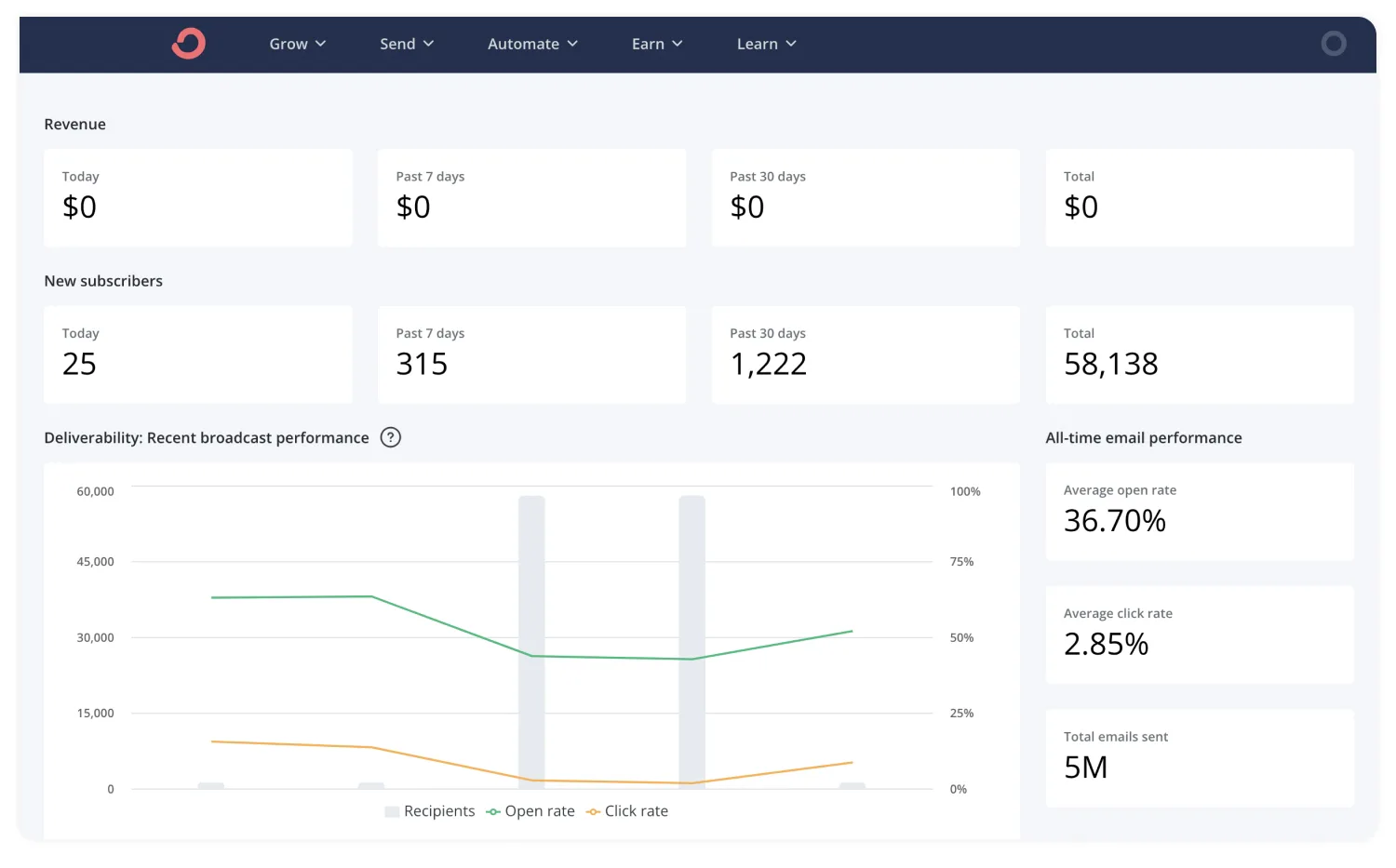
Real Food Dietician’s Kit dashboard.
But they’re not focused on growing their email list—what matters to them is building an engaged list. Here’s how they’ve increased opens and clicks since switching to Kit:
1. Doubling down on community
Before embarking on any migration project, it’s important to take a long, hard look at your email list. For Jessica and her team, that meant evaluating all 125,000 subscribers they had accumulated since 2015. Despite so many subscribers, their opens hovered between 10-12%, and clicks fell.
The first tactic they experimented with: segmentation and targeted opt-ins for specific email sequences. But their existing provider didn’t make that easy. “With Mailchimp, if the same person opts in to multiple lists, you pay for them in two different locations, and doing segments in Mailchimp felt difficult,” says Jessica.
Without a more targeted approach, they dove into their email hygiene, pruning their email list by 50% to 58,000 before making the leap to Kit. “We figured out which subscribers actually wanted to hear from us,” she says. “125,000 feels great, but when you look at the open rate and compare it to the industry standard, we realized it was significantly lower.”
Decreasing the size of your email list can feel daunting, but it’s something you should consider doing on an annual basis, if not quarterly. Keeping an engaged email list isn’t just great for your opens and click-throughs but can also help you maintain stronger deliverability. To prune your email list:
- Start with your existing subscribers. Anyone who hasn’t opened or clicked on an email in the last 90 days are good candidates for pruning.
- Tag subscribers that fit those characteristics as “Cold” or however you want to remember that they’re unengaged.
- Send one dedicated re-engagement campaign to those subscribers, asking if they still want to be a part of your email list and offering them a chance to unsubscribe. If they don’t open or click on that email (or opt-out), remove them from your list.
- In Kit, this step is even easier. If you go to your Subscribers page, you can set up an automation rule to remove these subscribers from your list. Here’s how.
Once Real Food Dietitians went through these steps, Kit made migration easy. “Becky and the Kit team did all the migration for us, and it was easy communication back and forth,” says Beacom.
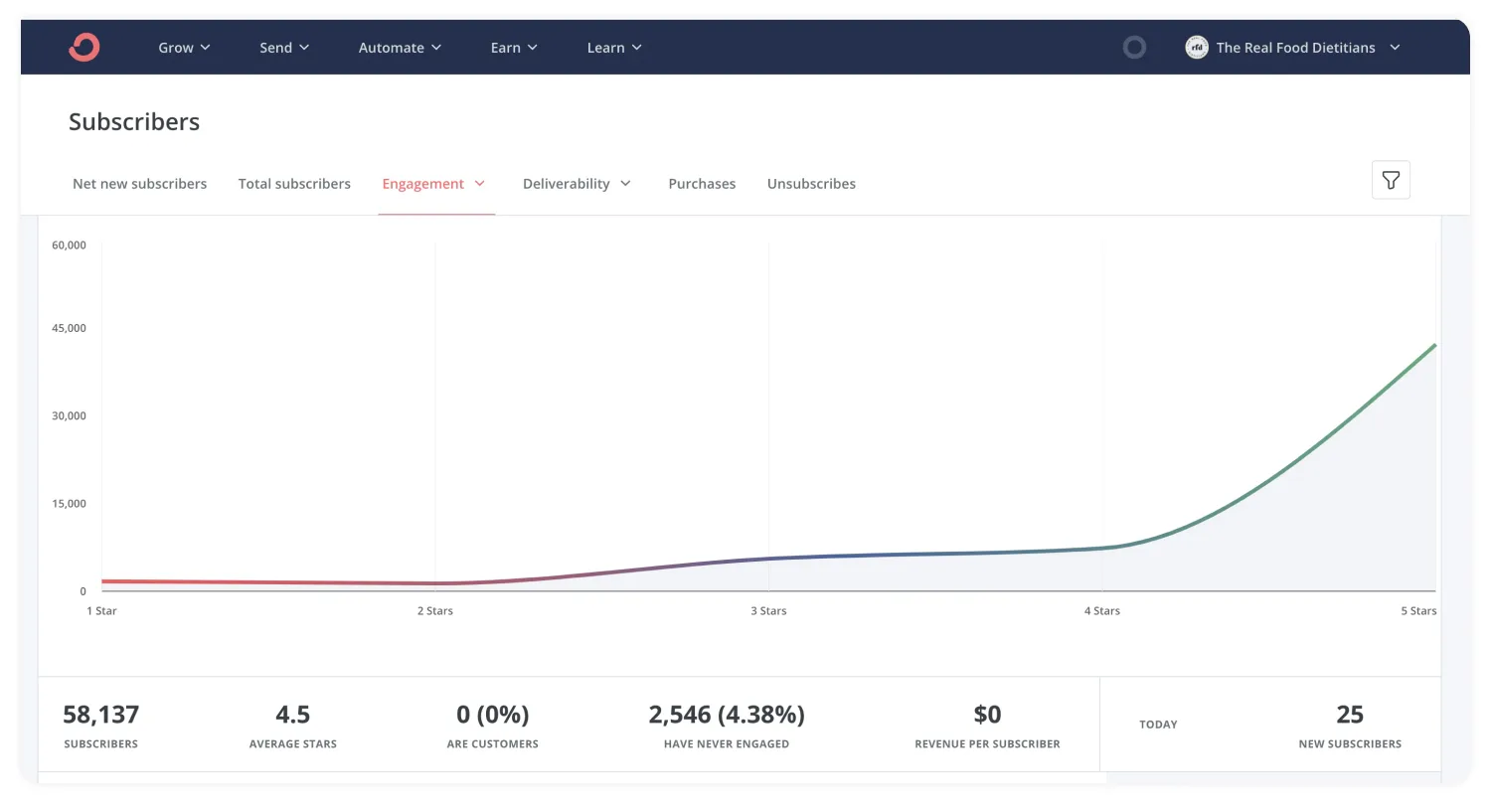
A snapshot of Real Food Dietician’s engagement metrics over time.
And it worked. Since migrating, open rates skyrocketed up to 30%.
2. Creating the best possible content
The best way to keep those open rates high is to deliver content your audience wants to read. So that’s what Jessica and her team spend most of their time on, making sure that every email that goes out is one that subscribers can’t help but open.
Jessica loves developing new recipes and trying new flavors for their audience. “A recipe blog post takes eight to ten hours by the time you concept and test it all the way to food photography and editing,” she says. “We’re always moving on to something new. My favorite recipe right now is the Burger Bowl with Special Sauce. It’s a favorite at my house.”
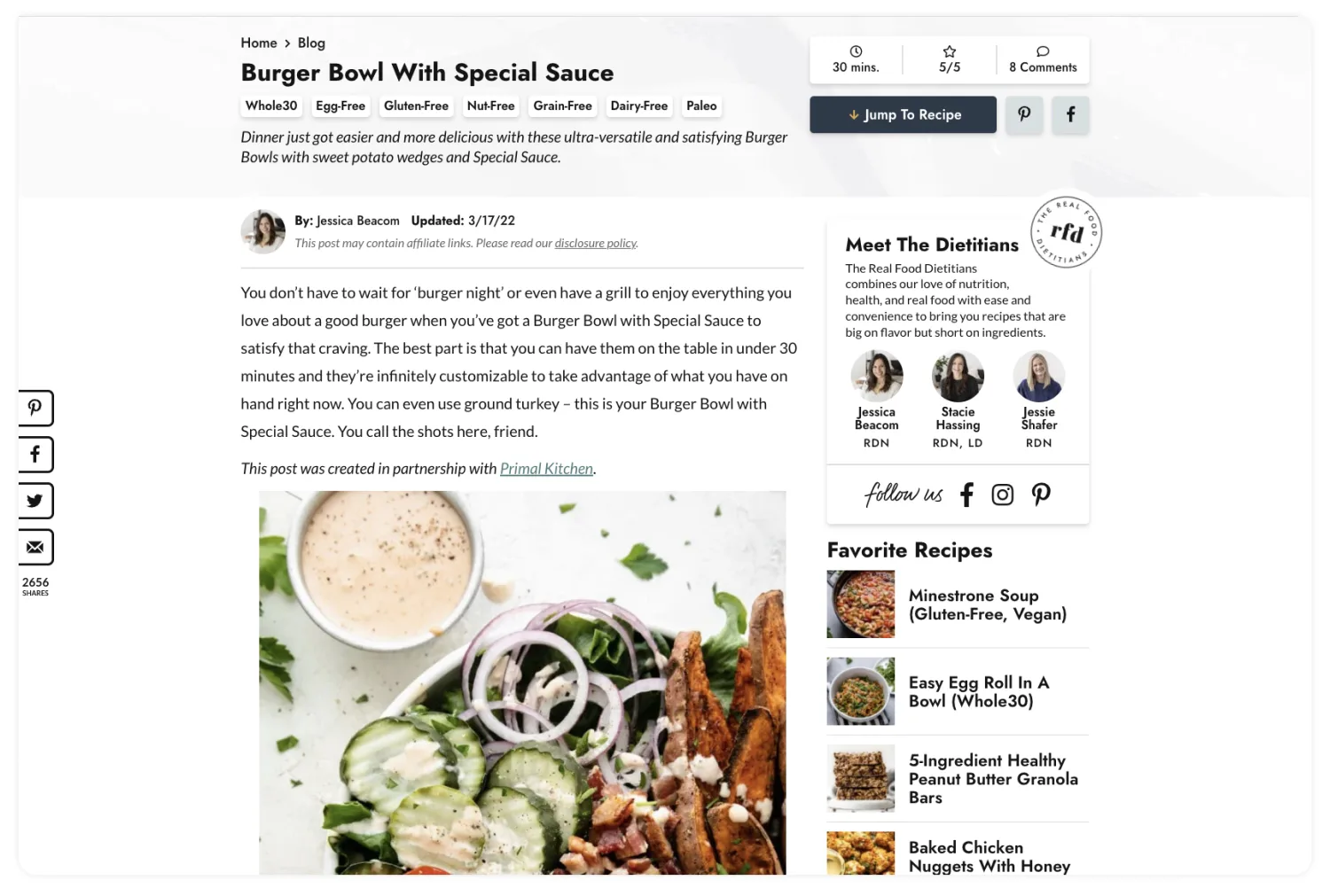
An example recipe from Real Food Dieticians.
Their editorial calendar is a mix between SEO-driven and what they know their audience is looking for based on the time of year. “We look and see how content performs over time and figure out what does well with historical data,” says Jessica. “For example, I look at last year’s emails we sent around Easter and see how it did before crafting this year’s email.”
3. Delivering content to their audience automatically
Jessica uses several Kit Automations to keep the conversation going with readers, new and old alike.
First, they welcome all new subscribers with an automated, five-email welcome sequence. All new subscribers receive one email each day with the top-performing content on the site to introduce them to the type of recipes, stories, and insights subscribers can expect to see. Here’s what that looks like in Kit:

All new subscribers receive a five-email sequence before getting dropped into their forever series.
And what it looks like in practice:

Beacom and her team compile the top-performing content for their forever series.
Once subscribers complete that first welcome sequence, they get dropped into an evergreen, automated “forever series” that sends once a week.
“Every Monday, we put out our highest-performing content that we feel delivers the most value,” says Beacom. “Most of it is things like five easy weeknight recipes or top five favorite recipes for a certain holiday. We pull which ones have the highest RPM for ad revenue over time, so we know they perform well.”
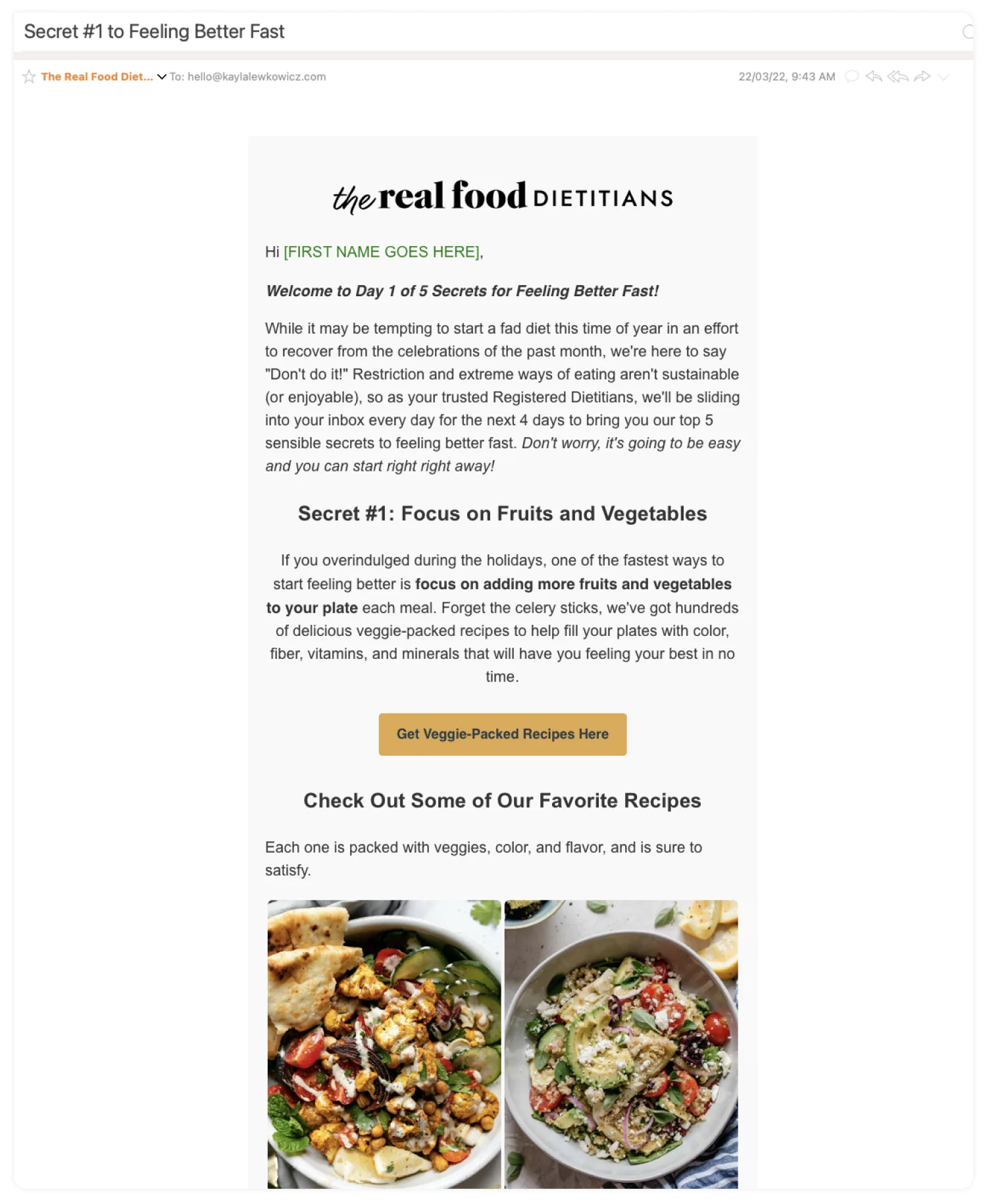
A sample of Real Food Dietician’s forever series.
The best part? Because this sequence is automated every week, the team can create the emails in batches and schedule them months in advance. This gives them peace of mind so that no matter what happens—like when one of their writers goes on maternity leave in a few months—their audience still gets the best of the best.
“This is my favorite part of using Kit,” says Jessica. “If we decided to shut our doors for a few weeks and take a vacation, we would still have content going out and staying top of mind with our readers. The platform just makes it easy.”
In addition to their weekly series, they also set up an RSS feed through Kit so dedicated subscribers always get the latest posts, which delivers within 30 minutes of a new piece going live. They use a simple template developed in Kit to make sure their readers stay informed.

For more dedicated subscribers, Real Food Dietitians set up an RSS feed through Kit.
…so when a new post drops, it looks like this:

Whenever a new post goes live, RSS subscribers see this email.
4. Weekly broadcasts that serve up the best recent posts
On top of their regular, pre-scheduled Automations, Real Food Dieticians send out weekly one-off emails timed with their editorial calendar on Saturdays.
Says Jessica, “Every month, we hold an editorial calendar meeting where we talk about what we’re going to post, but also how we’re going to promote it. There’s usually a weekly theme based on new posts or upcoming seasons or holidays based on what we think our audience will be interested in at that moment. For example, for back to school, we might focus on easy meals for busy weeknights or healthy snacks you can easily stick in a backpack.”
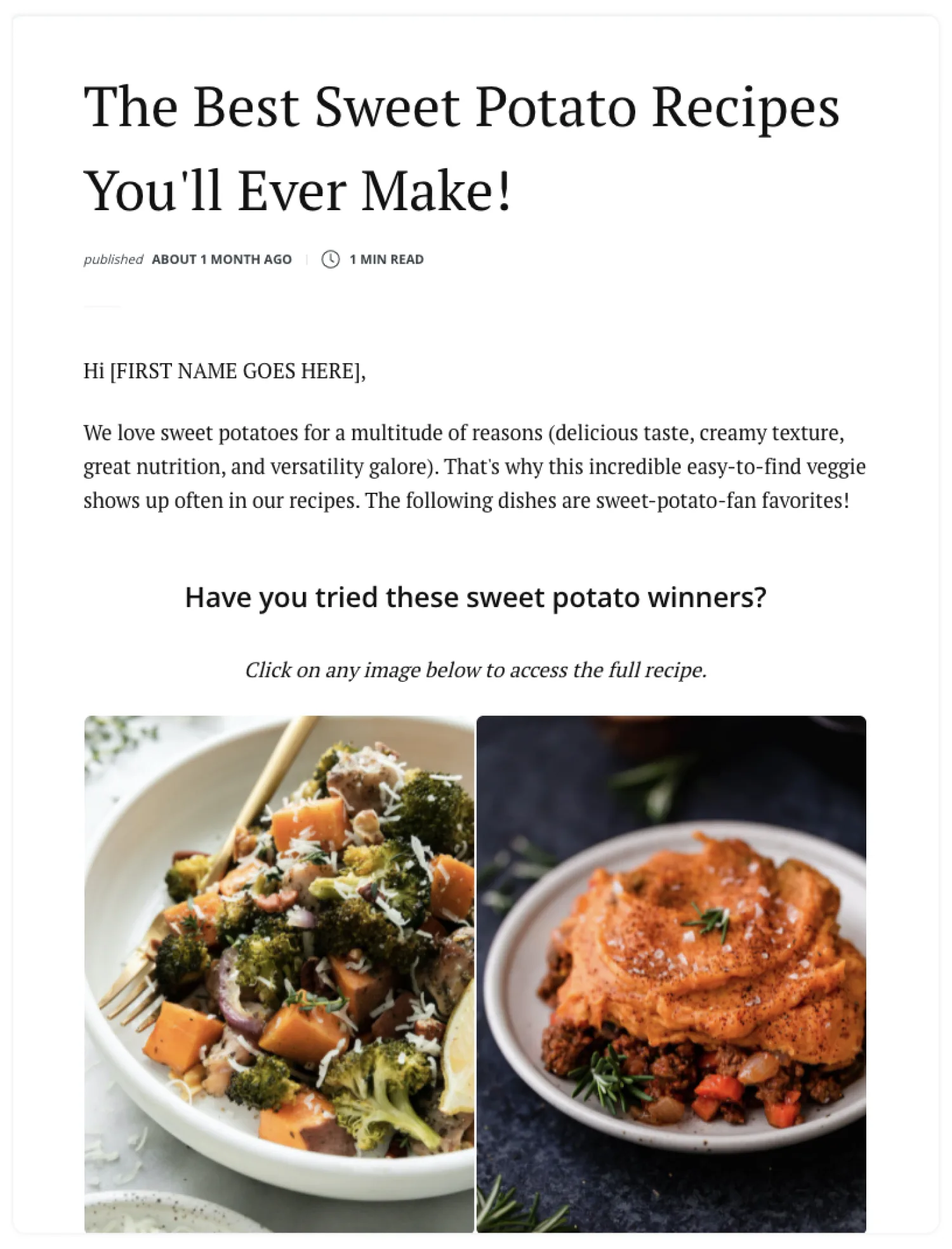
A recent Saturday broadcast all around sweet potatoes.
They build their Saturday calendar step by step with their regular editorial calendar, along with looking at historical data, often cascading content throughout multiple Saturdays and experimenting with placement.
They may also be driven by sponsorships or advertising agreements, but the email looks very similar and still focuses on great content:

A sponsored Saturday broadcast.
Jessica makes sure for every email they use Kit tags so they can tailor content more easily in the future. Setting up the tags takes a few minutes, but after that, anytime anyone clicks on a link that’s tagged a certain way, they automatically get added to a different list.
“It’s so much easier to add tags and do segmentation [in Kit],” she says. “I’ll tag the different links within the broadcast, so I know what people are interested in. As we get closer to summer, for example, we have a grilling tag, and we may send out a few dedicated broadcasts to anyone with that tag.”
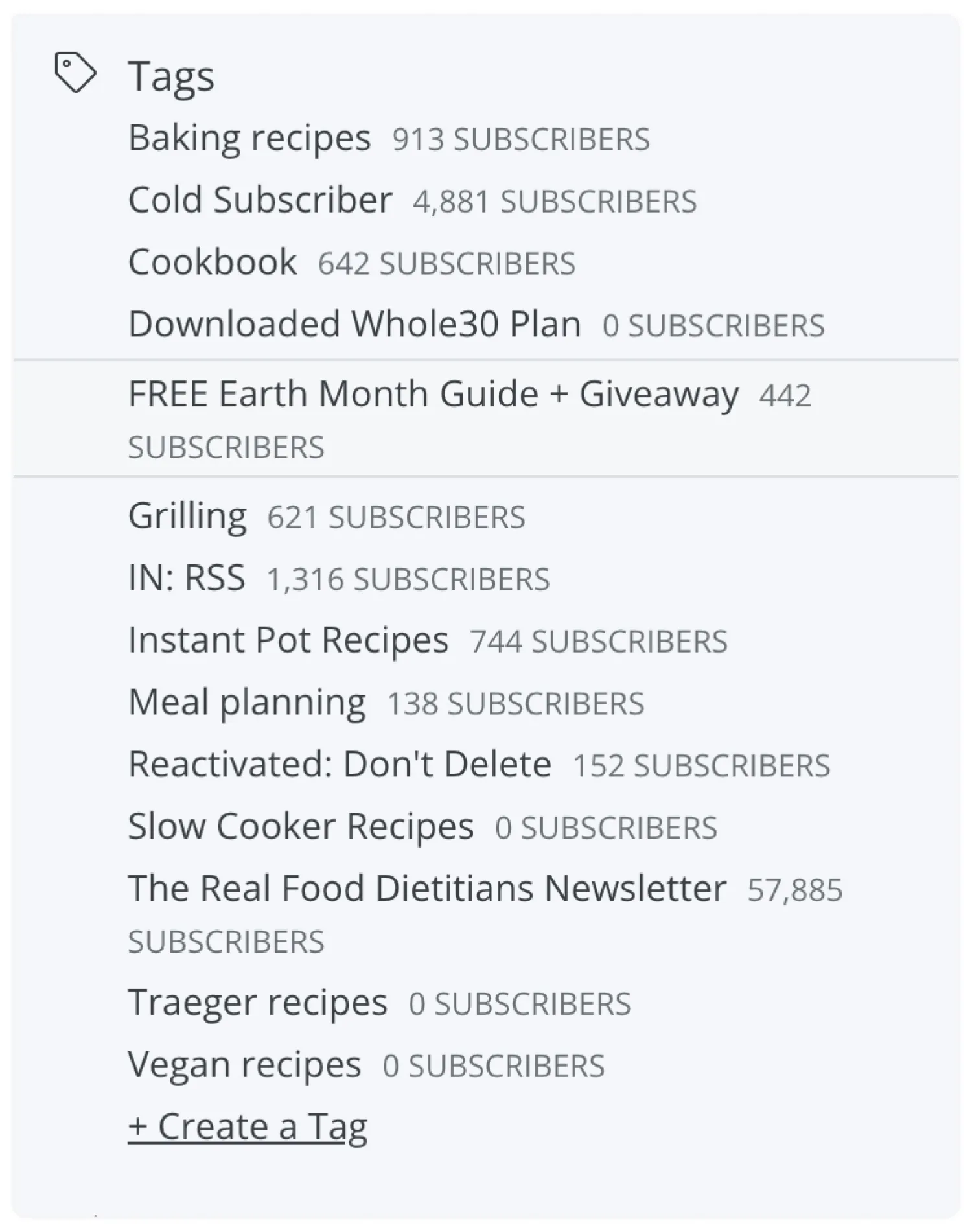
How Real Food Dieticians tags their content to create dedicated one-off emails based on topic in the future.
Right now, they’re keeping their focus on evergreen content, but with Kit, they know they can easily build something new. “We’re working on scheduling our evergreen content, and we have enough built out that come fall, we can start to work on something new. Kit makes that easy because all we have to do is grab the list IDs, drop them into forms on the back of our site, and we’re ready to rock and roll,” says Beacom.
5. Don’t be afraid of a smaller email list
Size does matter when it comes to your email marketing, but don’t be fooled by numbers alone. Engagement is what’s going to build a community. Instead of trying to be everything to everyone, show up for the people who want to hear from you.
“We used to panic when we’d have 100 unsubscribes after a broadcast email,” laughs Jessica. “What did we do wrong? Nothing. You have to do what’s best for your audience and create the content that they want to see, and don’t hold back.”
Whether you have an email list of 5 or 500,000, Kit’s creator marketing platform can help you build an engaged email list that’s excited to hear from you. Our creator marketing tools is so easy to use you can spend less time working on your emails and more time creating a community around your creative business — so you can stay doing what you love, creating.





